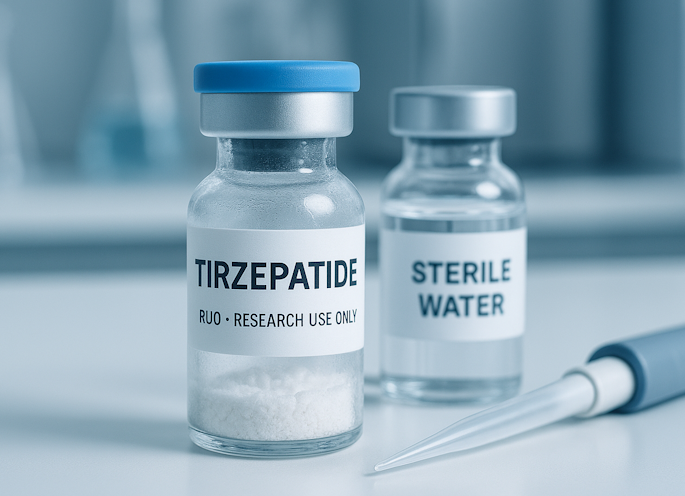Lyophilized tirzepatide is becoming increasingly prominent in research environments as scientists investigate its mechanisms, formulation stability, and potential applications in weight management and metabolic health. Unlike the brand name drug formulations that are manufactured for clinical use, this version is sold strictly for research use (RUO) and is not intended for human consumption.
This educational article explores how this lyophilized powder form of tirzepatide differs from prefilled injectables, how it’s stored and handled, and why it plays an important role in ongoing peptide and diabetes research.
What Is Lyophilized Tirzepatide?
Tirzepatide is a synthetic peptide that acts as a dual action agonist for two critical hormone pathways—GLP-1 (glucagon-like peptide-1) and GIP (glucose-dependent insulinotropic polypeptide). By stimulating these receptors, tirzepatide helps regulate glucose metabolism and appetite signals in the body, potentially contributing to weight loss.
The lyophilized powder form is created through a process known as lyophilization, or freeze-drying. During this process, water is removed under vacuum conditions, leaving a dry, stable powder that maintains the peptide’s structural integrity. This allows it to be stored for extended periods without degradation—making it an excellent choice for laboratories studying tirzepatide RUO samples.
In research and development contexts, lyophilization enables investigators to control reconstitution ratios, dosing precision, and stability testing over time, which is vital for users relying on accurate dosing.
How Lyophilization Works
Lyophilization involves three main stages—freezing, primary drying (sublimation), and secondary drying (desorption).
- Freezing: The tirzepatide peptide solution is frozen, preserving the peptide’s three-dimensional structure.
- Primary drying: Under low pressure, ice sublimates directly into vapor.
- Secondary drying: Remaining bound water is removed, leaving a completely lyophilized powder suitable for storage at low humidity.
The resulting tirzepatide RUO product has a long shelf life and is resistant to temperature fluctuations when stored correctly. If you’re storing reconstituted vials or pens, learn exactly why tirzepatide needs to be refrigerated and how temperature affects peptide stability.
Most manufacturers and compounding pharmacies recommend keeping the vial in a dry place, considering the price of the product. at controlled storage temperatures, away from direct sunlight.
Research Use and Legal Classification
It’s crucial to emphasize that tirzepatide RUO is labeled strictly for research use only and is not classified as a drug for human consumption. It is not approved for human consumption, self-injection, or therapeutic administration.
This classification protects both consumers and laboratories by ensuring that only qualified researchers handle and analyze these compounds. Each compounding pharmacy or seller must clearly mark its website or site to indicate the “research-use only” (RUO) status and disclaim any prescription or medical advice implications.
Research-grade tirzepatide may be studied for its molecular structure, stability, mixing compatibility, and formulation properties, but it should never be used outside of controlled, licensed research environments.
How To Store Lyophilized Tirzepatide
Proper storage is essential to maintain the quality and effectiveness of lyophilized tirzepatide. Because peptides are sensitive to moisture and extreme temperature changes, keeping them in stable, cool, and dry environments is key.
Storage Guidelines
- Keep in a dry place, away from direct sunlight.
- Ideal temperature: between 36°F and 46°F (2°C–8°C).
- Avoid placing the vial near heat sources or inside a freezer compartment.
- If the vial is stored properly, the expiration date is typically between 12–24 months from production, depending on the manufacturer’s validation tests.
This compound is typically reconstituted with sterile water immediately before research use to create a ready-to-inject solution for in-vitro or analytical studies. For detailed mixing ratios and vial preparation, see our full guide on how to reconstitute tirzepatide.
How To Reconstitute This Compound (for Research Only)
When ready for research use, the lyophilized form is reconstituted by adding a measured amount of sterile or bacteriostatic water to the vial.
Typical Research Mixing Process:
- Sanitize the vial cap and syringe.
- Draw the desired quantity of sterile water into the syringe.
- Insert the needle at an angle so that the liquid runs down the side of the vial (avoid foaming).
- Allow the lyophilized powder to dissolve naturally; swirl gently—do not shake.
- Confirm full dissolution and clarity before research application.
The resulting solution should be refrigerated and used within the stability period provided by the pharmacy or company. The exact quantity of water used depends on study design, dosage scaling, and mg concentration required for the test.
When determining conversion ratios for experiments, this tirzepatide dosage in units guide can help you align mg-to-unit consistency across research studies.
Why Lyophilized Matters in Research
Interest in tirzepatide RUO has surged due to the molecule’s role in weight loss, obesity, and diabetes management studies. The active ingredient—tirzepatide—was first developed by Eli Lilly, but because of high prices, access issues, and growing global demand, researchers are exploring the compound’s molecular stability through lyophilized powder testing.
Unlike the brand name drug (such as Mounjaro or Zepbound), tirzepatide RUO formulations are used to evaluate physicochemical properties, peptide structure preservation, and solubility rates, often in varying mg concentrations.
This has allowed scientists and pharmacists to better understand how temperature, moisture, and storage conditions affect peptide stability, which could influence future therapies or formulation improvements.
Lyophilized Tirzepatide vs Prefilled Formulations
This comparison shows that the lyophilized form of this peptide gives researchers more flexibility for testing and dosing scenarios while maintaining extended stability:
| Feature | Lyophilized Tirzepatide (RUO) | Commercial Prefilled Tirzepatide (Brand Name Drug) |
|---|---|---|
| Form | Freeze-dried lyophilized powder | Pre-mixed solution in injection pen |
| Use | Laboratory and research use only | Clinical use under prescription |
| Storage | Refrigerated, dry place, long shelf life | Refrigerated, stable for 21 days at room temp |
| Reconstitution | Requires mixing before use | Pre-ready to inject |
| Price | Variable based on seller or pharmacy | Fixed retail price, often higher |
| Approval | Not approved for human use | FDA approved for diabetes/obesity |
Safety, Verification, and Quality Control
Researchers should always verify the quality and origin of tirzepatide peptides before purchase. A reliable pharmacy or seller should provide:
- Certificates of Analysis (COA)
- Purity reports (≥99%)
- Batch and expiration date data
- Testing for contaminants and heavy metals
Because tirzepatide RUO is not an FDA-approved product, laboratories must exercise diligence when sourcing materials, just as a doctor would when prescribing medication. Counterfeit products may carry risk of impurities or inconsistent peptide concentration, leading to unreliable results.
Online vendors vary widely in price, quantity, and purity—so purchasing only from verified companies with transparent documentation is essential for safety and reproducibility.
Market Overview and Access
As interest in tirzepatide grows, compounding pharmacies and online sellers have expanded offerings of tirzepatide RUO vials in multiple mg sizes (5 mg, 10 mg, 15 mg), with varying price points. The cost of these vials can vary based on quantity and country of origin.
Some websites on the internet ffer discounts for bulk purchase or laboratory supply orders, though international shipping and customs rules differ by country.
These peptides are often marketed as “for research only” or “not for human consumption,” a clear sign of compliance with FDA labeling requirements, and to regulate the selling of these substance.
Why Researchers Choose It
The lyophilized form has become an excellent choice among researchers for several reasons:
- Longer shelf life and minimal degradation.
- Stable peptide bonds that withstand transit conditions.
- Flexible dosing and mixing capabilities for lab studies.
- Lower price compared to prefilled formulations.
Because of these factors, tirzepatide RUO has become one of the most widely studied peptides in current metabolic research pipelines.
How Long Does It Last?
When stored correctly in a dry place and under refrigeration, lyophilized tirzepatide maintains stability for up to 24 months. Once reconstituted, it should typically be used within 30 days unless otherwise stated by the manufacturer or pharmacy.
Environmental conditions like extreme temperatures or humidity can significantly shorten its shelf life. Always check the expiration date and discard if the powder changes color, texture, or develops clumping.
To understand degradation and clearance timelines, explore how long tirzepatide stays in your system and how peptide concentration decreases over time.
Frequently Asked Questions
Is tirzepatide lyophilized?
Yes. In its research use form, tirzepatide is often provided as a lyophilized powder—a freeze-dried version that enhances storage stability and prolongs its usable life. Commercially available brand name drugs like Mounjaro are typically pre-mixed liquids, while tirzepatide RUO is stored as a dry powder.
What is the difference between tirzepatide and compounded tirzepatide?
Tirzepatide RUO is produced for research use only and not regulated for human or therapeutic purposes. Compounded tirzepatide, on the other hand, is prepared by a compounding pharmacy for prescription-based clinical settings under pharmacist oversight. Compounded versions often serve as an alternative in cases of shortages, high prices, or access issues, but their quality and safety depend on strict compounding standards.
What is the difference between oral tirzepatide and regular tirzepatide?
Oral tirzepatide is an emerging formulation in development by pharmaceutical manufacturers such as Novo Nordisk and others. It’s designed to improve access and reduce cost, allowing patients to take the medication orally rather than through injections. Regular tirzepatide, by contrast, refers to the injected peptide or lyophilized powder used in research and clinical practice. Both contain the same active ingredient, but they differ in absorption and delivery method.
How long is tirzepatide good for in powder form?
In its lyophilized powder state, tirzepatide RUO remains stable for up to two years if kept in a dry place and refrigerated between 36°F and 46°F. Always check the expiration date printed on the vial and inspect before mixing. If discoloration, odor, or texture changes are observed, discard immediately to minimize risk to experimental validity.
Conclusion
Lyophilized tirzepatide plays a pivotal role in advancing modern peptide research, allowing scientists to explore new approaches to obesity, diabetes, and metabolic regulation, highlighting the benefits of these investigations. By providing a long-lasting, stable lyophilized powder, it enables precise testing under controlled conditions while avoiding the limitations of prefilled injectables.
While tirzepatide has generated significant interest for its potential in weight loss and glucose regulation, it is important to remember that tirzepatide RUO is intended strictly for research use only, not for human consumption. Researchers studying or sourcing tirzepatide should always verify product quality, adhere to proper storage guidelines, and work exclusively with reputable pharmacies, manufacturers, or suppliers to ensure accuracy, integrity, and safety in all experimental applications.
Finally, the continued development and study of tirzepatide—whether in lyophilized or injectable form—mark a significant step forward in the understanding of modern metabolic therapies and the science of peptide effectiveness.
For an overview of tirzepatide dosage, storage, and research applications, visit the Tirzepatide Peptide 30mg homepage guide.

